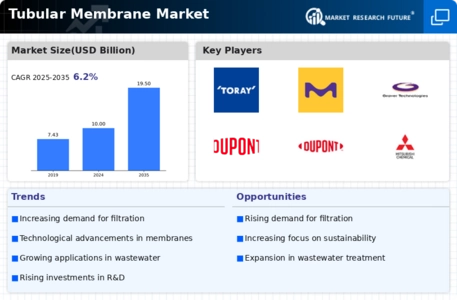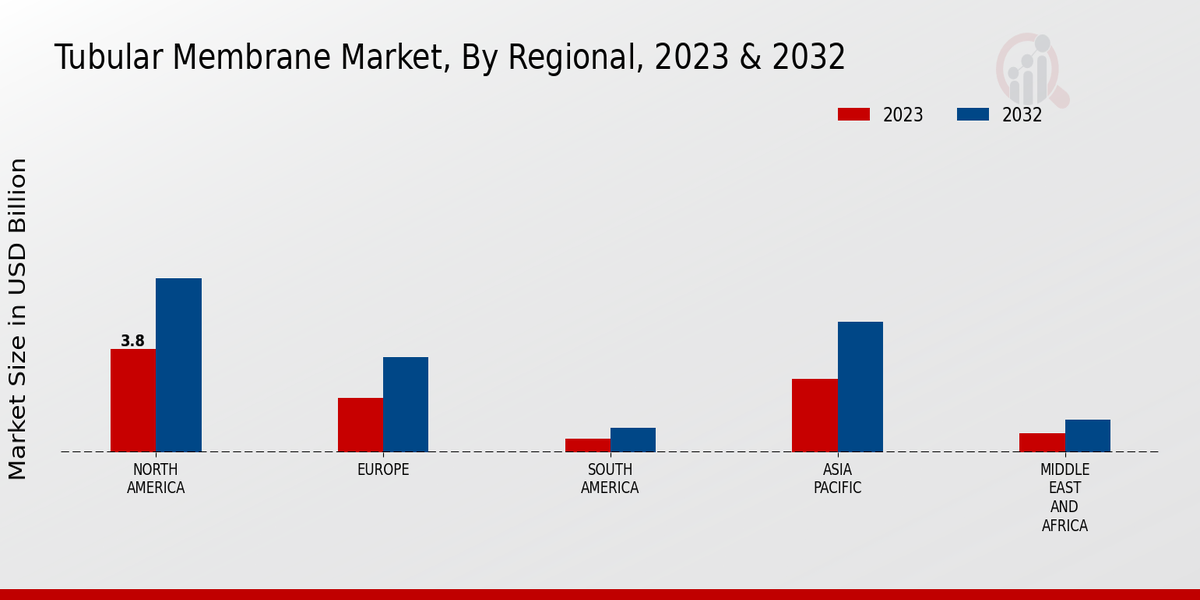Market Growth Projections
The Global Tubular Membrane Market Industry is projected to experience robust growth over the next decade. With a market value anticipated to reach 10.0 USD Billion in 2024 and further expand to 19.5 USD Billion by 2035, the industry is poised for significant development. The compound annual growth rate of 6.22% from 2025 to 2035 indicates a sustained upward trend, driven by various factors such as technological advancements, regulatory support, and increasing industrial applications. This growth trajectory reflects the industry's adaptability and responsiveness to global challenges, positioning the Global Tubular Membrane Market Industry as a key player in the future of water treatment and filtration technologies.
Regulatory Support for Water Quality Standards
The Global Tubular Membrane Market Industry benefits from stringent regulatory frameworks aimed at ensuring water quality and safety. Governments worldwide are implementing regulations that mandate the use of advanced filtration technologies in wastewater treatment and drinking water purification. This regulatory support fosters a conducive environment for the adoption of tubular membranes, as they meet the required standards for contaminant removal. The increasing enforcement of these regulations is likely to drive market growth, as industries seek compliance through effective membrane solutions. Consequently, the Global Tubular Membrane Market Industry is poised for expansion, driven by the need for adherence to evolving water quality standards.
Increasing Demand for Water Treatment Solutions
The Global Tubular Membrane Market Industry experiences a notable surge in demand for advanced water treatment solutions. As urbanization accelerates and water scarcity issues become more pressing, municipalities and industries are increasingly adopting tubular membranes for efficient filtration processes. This trend is underscored by the projected market value of 10.0 USD Billion in 2024, reflecting a growing recognition of the technology's effectiveness in removing contaminants. Additionally, the emphasis on sustainable practices drives investments in membrane technologies, further propelling market growth. The Global Tubular Membrane Market Industry is thus positioned to play a crucial role in addressing global water quality challenges.
Growing Awareness of Environmental Sustainability
The Global Tubular Membrane Market Industry is significantly influenced by the increasing awareness of environmental sustainability among consumers and businesses. As organizations prioritize eco-friendly practices, the demand for technologies that minimize waste and energy consumption rises. Tubular membranes, known for their efficiency in resource utilization, align with these sustainability goals. This growing consciousness is prompting investments in membrane technologies, as companies seek to enhance their environmental credentials. The market's trajectory is thus positively impacted, as the Global Tubular Membrane Market Industry continues to evolve in response to the demand for sustainable solutions in water treatment and industrial processes.
Technological Advancements in Membrane Technology
Technological innovations significantly influence the Global Tubular Membrane Market Industry, enhancing the performance and efficiency of tubular membranes. Recent advancements, such as the development of high-flux membranes and improved fouling resistance, contribute to the broader adoption of these technologies across various sectors. For instance, the integration of nanotechnology in membrane fabrication has shown promising results in increasing permeability while maintaining selectivity. As a result, the market is expected to grow substantially, with projections indicating a rise to 19.5 USD Billion by 2035. These advancements not only improve operational efficiency but also reduce energy consumption, aligning with global sustainability goals.
Rising Industrial Applications of Membrane Technology
The Global Tubular Membrane Market Industry is witnessing a significant increase in industrial applications, particularly in sectors such as food and beverage, pharmaceuticals, and chemical processing. The versatility of tubular membranes allows for their effective use in various separation processes, including concentration, purification, and recovery. As industries strive for efficiency and sustainability, the adoption of tubular membranes is becoming more prevalent. This trend is expected to contribute to a compound annual growth rate of 6.22% from 2025 to 2035, reflecting the growing recognition of membrane technology's potential in enhancing operational efficiency and product quality across diverse industrial applications.



















Leave a Comment